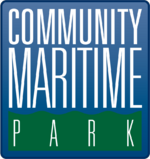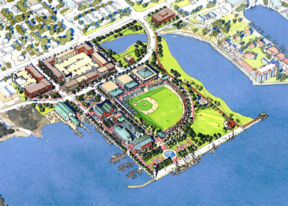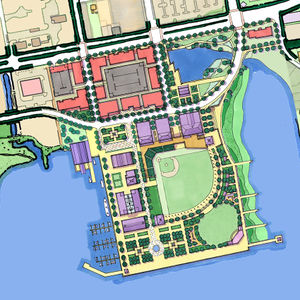Community Maritime Park
| | |
| Type | mixed-use public/private |
| Size | 30 acres |
| Facilities | multi-use stadium maritime museum UWF classrooms conference center concert green |
| Operated by | Community Maritime Park Associates |
The Vince Whibbs Sr. Community Maritime Park (often abbreviated to Whibbs Park, Community Maritime Park or CMP) is a project planned to occupy the 30-acre Trillium property on Pensacola's waterfront. It was developed by the Community Maritime Park Associates (CMPA), initially comprised of Vice Admiral Jack Fetterman, UWF President John Cavanaugh and Pensacola Pelicans owner Quint Studer. After the death of Admiral Fetterman, the third principal position was filled by Mayor Emeritus Vince Whibbs, after whose death the position was again filled by Judge Lacey Collier.
The plan, refined in public focus groups by urban planner Ray Gindroz, includes a maritime museum and research center, a "multi-use" stadium for the Pelicans, a conference center, university classrooms, a large public lawn and concert shell, mixed-use commercial space and other amenities. On January 18, 2005, the Pensacola City Council approved the plan by an 8-1 vote. Shortly thereafter, the political action group Save Our City, led by Charles Fairchild and dissenting city councilman Marty Donovan, started a petition to force a city referendum on the issue, hoping to overturn the council's decision. After a long and divisive campaign by both sides, the plan was approved by the voters of Pensacola on September 5, 2006.
The twelve-person Community Maritime Park Associates board of trustees was selected both by the CMPA principals and by the Pensacola City Council. On April 13, 2007, the board selected the architectural firm Caldwell Associates, which had been involved in preliminary development, as its top choice to write the final design criteria.
Contents
Plan Details
Multi-use Stadium
One of the largest (and most criticized) elements of the park is the stadium that will serve primarily as a home ballpark for the Studer-owned Pensacola Pelicans. When not in use, the outfield walls can be removed to connect the space with the waterfront concert green.
Park proponents argue that the 3,500-seat stadiums can be used for a number of outdoor activities, including concerts, graduation ceremonies and other sporting events, but critics dispute its "multi-use" capabilities.
Maritime museum & research center
The western side of the property will feature a 50,000 square foot maritime museum and research center. Conceived by the late Vice Admiral Jack Fetterman, for whom it was later named, the $18 million museum will be funded half by private donations and half by the State of Florida's Alec P. Courtelis Matching Gift Program.
The museum's interactive, educational displays will showcase artifacts from Pensacola's maritime history. The University of West Florida will operate active research facilities in the areas of public history, underwater archaeology, marine biology and environmental science.
University classrooms & conference center
The University of West Florida will also host classes for its business and continuing education departments at the Park. Although
Public green space & waterfront access
The entire southern end of the Park property adjacent to Pensacola Bay will be converted to a public concert green and waterfront promenade. Retired insurance executive R. K. "Skip" Hunter donated $1 million to the project in 2006 for the construction of a concert shell on the property's southeast corner.
Mixed-use commercial space
Several buildings will be constructed on the northern end of the property, to be leased to third parties for retail shops, restaurants and other uses. These leases are expected to generate a large portion of the Park's revenue.
Other features
The Park will also include landscaped gardens and fountains, gazebos, a breakwater and marina, and eventually a lighthouse, although rising costs have forced the development team to postpone these features until an unspecified time, when additional revenue enables a "Phase II."
Background and timeline
The 30-acre Trillium property, a peninsular lot south of Main Street roughly between Spring and De Villiers Streets, had been purchased by the City of Pensacola for $3.63 million on March 28, 2000. On May 31, 2001, a Festival Park project was proposed by Bullock Tice Associates to occupy the site. The $40 million plan, which included a 16-acre public park, an $18 million auditorium (to replace the aging Bayfront Auditorium on Palafox Street) and space for future development, was approved by the Pensacola City Council on November 21, 2002. Initial work had already begun, including a massive concrete group called Citizens Against Trillium (which included Charles Fairchild) petitioned for a referendum on the project. On March 25, 2003 the citizens of Pensacola voted to overturn the Council's decision and scrap the plan.
In late 2004, months after Hurricane Ivan devastated the Pensacola area, city leaders including City Manager Tom Bonfield and Mayor John Fogg met with Admiral Fetterman and others to discuss ideas about a possible "maritime park" project for the Trillium site. The Community Maritime Park Associates was formed and presented a preliminary proposal to the Pensacola City Council, which approved the concept on January 18, 2005.
Criticisms and response
Referendum
Development
Environmental work
The soil of the Trillium property is contaminated with petroleum and arsenic and must be treated before construction can begin. In addition, about four acres of the property are wetlands, which much be guarded against the development or mitigated by creating new wetland areas nearby. The necessary permits were submitted to state officials on August 15, 2007, and often take up to a year to be approved. According to Florida Department of Environmental Protection Northwest District Director Dick Fancher, "So much depends on how complete the application is and how complicated it is." When asked if the CMP's permits might be approved more quickly, he said, "I don't know if there's sticking points but there's definitely issues to look at. I don't think it's an impossibility."[1]
Financial troubles
In early June 2007, Governor Charlie Crist vetoed about $2.5 million in state funds that had been expected for environmental cleanup.[2] In addition, dramatic property tax reforms enacted by the Florida legislature could cause a budget shortage that would force a reevaluation of the project.[3]
External links
- City of Pensacola website - Official documents and CMPA Board minutes/agendas
- ProPensacola.com
- UWF site for the Maritime Museum
References
- ↑ Maritime Park Milestone, Independent News, September 6, 2007.
- ↑ "Park money at risk." Pensacola News Journal, June 7, 2007.
- ↑ "Park money at risk." Pensacola News Journal, March 11, 2007.





